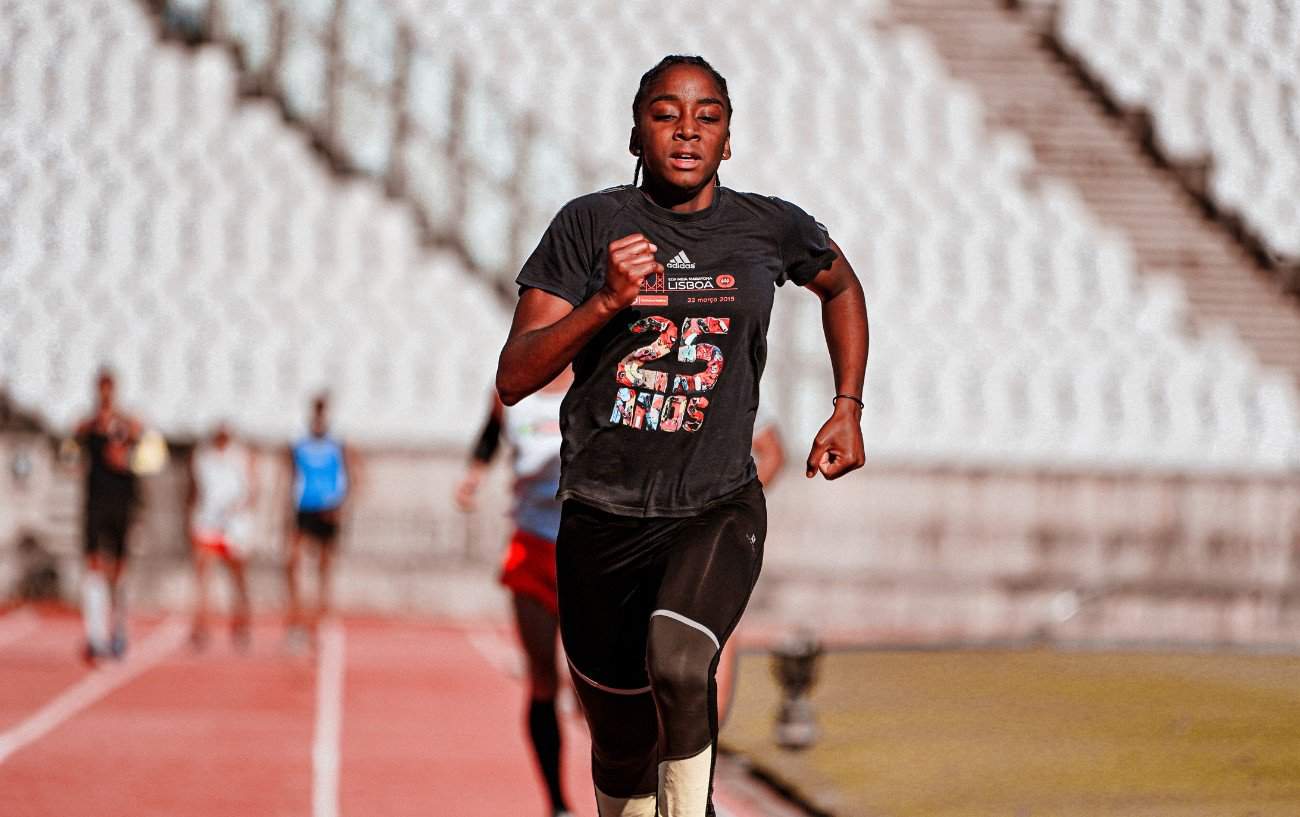Bagging a 7-minute mile is a great goal for recreational runners because it’s fast but achievable and rewarding with determination and hard work.
And a mile is a satisfying distance to race. Don’t you remember from high school gym class? Four clean loops of a running track, legs going hard, breath working to catch up, and before you know it, it’s all over.
Improving your mile pace can have an amazing ripple effect on other areas of your running. Working on speed can improve your running form, cadence, and leg strength.
And don’t forget, running a mile, however fast you manage to go, is still an aerobic event as apposed to an anaerobic event like a short sprint.
Improving your top aerobic output in a mile will benefit your endurance running in general and help you run faster, whether your favorite distance is a 5K, a marathon, or beyond.
In this guide we will take you through how to train for a 7 minute mile, example workouts to add to your training plan, and our top tips to help you reach this goal.

What Is A 7 Minute Mile Running Pace?
When in training or attempting your mile effort, the 7 minute mile pace you want to see on your GPS watch is the following:
7 Minute Mile Pace Chart
– 7:00 minutes/mile
– 4:20 minutes/kilometer
– 1:45 minutes per lap around the running track
You should try to keep as close to this pace as possible, or even run 1-2 seconds faster when possible to leave a slight cushion.
Am I Ready To Run A 7 Minute Mile?
Running a 7 minute mile is a reasonable goal for a lot of runners. Chances are, if you’re reading this right now, you’re in the 7 minute mile ballpark.
Maybe you’re close to an 8 minute mile, maybe you can run a 7:30, or even 7:15. This would be a perfect range from which to begin training for that 7 minute mile goal.
If you don’t currently know how fast you can run a mile, before you throw yourself into training for a 7 minute mile, it is important to evaluate your current level of fitness to see if it is a realistic goal for you.
What is the best way to see how fast you can run a mile?
Run a test mile.
Related: What’s A Good Mile Time? Average Times To Run A Mile By Age And Sex (See how you stack up with your peers, elite runners, and even the world record!)

How Do I Run A Mile Test?
It’s simple but not easy!
When you run a test mile, you’ll want to give your best effort for one mile. Your breathing and heart rate will be way up there throughout the entire test.
It’s a good idea to pick a day when you are not tired or sore from a recent run or other activity. Find a flat location where you can run one mile without interruption. The most ideal pace is on a track.
Warm-up with ten to fifteen minutes of easy jogging, followed by a few strides (short accelerations).
Once you are warmed up, run your test mile.
Run the mile as evenly as possible, but push yourself hard enough to end your mile feeling like you could not run much farther at that pace.
Now you know your current mile running time!
If you ran your mile in 8 minutes or less, then a 7 min mile is a reasonable goal for you!
If you were a bit slower, then consider setting a goal one or two minutes faster than your current time. And, of course, if you surprised yourself and already hit the 7-minute mark, consider aiming for a 6-minute mile!

How Many Miles A Week Should I Be Running To Train For A 7 Minute Mile?
This depends on where you’re starting from.
If you are not currently running and are a beginner, you’ll need to spend a few weeks running at a low-intensity pace to build up your weekly mileage to at least 15-20 miles a week before beginning any kind of regular speedwork sessions.
How Long Does It Take To Train For A 7 Minute Mile?
This will also vary from runner to runner.
If you’re an avid runner, your training plan will likely be about eight weeks long.
Lanni Marchant, an elite marathoner and coach at Tagalong with a Pro, recommends the following:
“Your training period will depend on how much running you’ve done before. On average, I would recommend 8 weeks at a minimum. That’s a good training block for any kind of distance.”
How Should I Train For A 7 Minute Mile?
When training for a fast mile, a runner should do the bulk of their runs at an easy pace with two higher intensity sessions mixed in per week.
This could look like 3 or 4 easy run days and two days of speedwork training. You could also switch out an easy day or two for cross training such as biking or elliptical.
For a well-rounded training plan, runners should always include strength training along with some mobility sessions. Check out our guide complete with full videos of each mobility exercise here.
A balance of strength sessions and mobility sessions will reduce your risk of injury while you train. Additionally, working on your strength will give you more muscular power to tackle that mile distance and bag that time.

What Are Some Example Speed Sessions?
Incorporating speedwork into your training routine is key to tackling the one-mile distance. Speedwork helps you get comfortable at faster speeds, build your endurance to maintain them, and improve your stride and turnover.
Here are just a few speed session examples that you can include in your 7 minute mile training program:
- Warm up and do 200-meter repeats or 400m repeats at a pace faster than a 7 minute mile pace, closer to a 6-6:30 mile pace.
- Warm up and then do a fartlek training session with 80—or 90-second intervals and a 60-second jog between each interval.
- Warm up and do 12 x 1 minute hard/1 minute easy. Begin at a 20-minute race pace for the first four intervals, then work down to a 10-12-minute race pace for the middle four, and then finish the final four at your mile race pace. Cool down with a 10-20 minute easy jog.
- Warm up for 1-2 miles, run 2 miles holding a 7:00-7:30 minute mile threshold pace, and then run one cool-down mile.
- Warm up and run 3 or 4 800-meter efforts at a 7:00-7:30 minute pace with 2-3 minute jogging rest between each hard interval.
Perform any of these on a track or on any flat road or trail where you can run fast and uninterrupted.
You should ideally be including two of the above speed sessions every week.
This may sound like a lot, but the great thing about speedwork training sessions is that they really pack a punch in a short amount of time. They are an efficient way of getting in a serious session even if you’re short on time.

Should I Include Strength Training Into My Plan?
Should you incorporate strength training into your one-mile distance training plan? The answer, yes!
In fact, strength training should always feature in your running training plan, regardless of your goal distance.
Strength training will keep you strong, and according to studies,1Fleck, S. J., & Falkel, J. E. (1986). Value of Resistance Training for the Reduction of Sports Injuries. Sports Medicine, 3(1), 61–68. https://doi.org/10.2165/00007256-198603010-00006 making strength training a part of your regular practice will also reduce your risk of injury.
A 2017 systematic review in the Journal of Strength and Conditioning2Schoenfeld, B. J., Grgic, J., Ogborn, D., & Krieger, J. W. (2017). Strength and Hypertrophy Adaptations Between Low- vs. High-Load Resistance Training. Journal of Strength and Conditioning Research, 31(12), 3508–3523. https://doi.org/10.1519/jsc.0000000000002200 found that runners who strength train regularly improve their oxygen uptake (or VO2 max), lactate threshold, running economy, and musculo-tendon stiffness.

So what kind of strength training sessions should you include in your one-mile training plan?
The focus for the bulk of your strength sessions should be on those muscles that you will use most in your mile run trial. Some examples of exercises include:
- Squats
- Lunges
- Deadlifts
- Bridges
- Step Ups
- Plank Variations
The Test: Running Your 7 Minute Mile
You’ve put in all the hard work in training, now it’s time for the big day, good luck!
To make sure that it all runs smoothly, here’s our guide.
Just as you did with your initial test mile, choose a day when you are well-rested and not achy or sore from training. If possible, run your mile on the same route or track you used before. That way, your time comparison will be as accurate as possible.
Do a proper warm up. Jog for 10-20 minutes, perform some dynamic drills, and follow up with some short strides.
Take a few deep breaths, remind yourself that you’ve got what it takes, and go for it!
As soon as you start, aim for the pace. Run on the 7 minute mile pace, or a couple of seconds faster. Keep that pace. As you round the corner of the finishing straight- sprint! Give it all you’ve got!
Bask in the glory of your achievement. You smashed it!
And if you fell a couple of seconds short of your target, keep chipping away, there’s always tomorrow.
Inspired To Stick To A Training Plan?
There’s no better way to become a stronger and faster runner than to follow a well-thought-out training plan written by a running coach. Whether you want to run short or long distance races, grab your running shoes and check out our very own Marathon Handbook training plans here:
Couch To 5K: Complete Training Plan And Running Guide











